Статьи журнала - Журнал стресс-физиологии и биохимии
Все статьи: 984
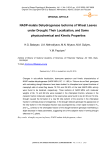
Статья научная
Changes in sub-cellular localization, isoenzyme spectrum and kinetic characteristics of NADP-malate dehydrogenase (NADP-MDH, EC 1.1.1.82) in Triticum durum Desf. genotypes with contrasting drought tolerance have been studied. In chloroplast and cytosol fractions of mesophyll cells of wheat flag leaves 70-75% and 25-30% of the total NADP-MDH activity were found to be localized, respectively. Three isoforms of NADP-MDH with molecular weights of 66, 74 and 86 kDa were revealed in the chloroplast fraction, whereas in the cytosolic fraction molecular weights of the isoenzymes were found to be 42, 66 and 74 kDa. Drought caused the formation of a new 90 kDa isoform of the enzyme in the chloroplast fraction in anthesis phase of ontogenesis. In the drought-tolerant genotype the appearance of the new isoform in the chloroplast fraction was accompanied by a more rapid increase in K m and V max contrary to the chloroplast fraction of the drought-sensitive genotype manifesting a slight decrease in these parameters, suggesting one of the adaptive traits in forming drought tolerance in C 3 plants.
Бесплатно

Статья научная
Repurpose of recognized compounds and medications as anti-COVID 2019 (anti-CoVID-19) agents, in anti-SARS-CoV-2 operation, via biological re-assessment of their activities, is a recent and durable development for pandemic COVID-19 novel drugs in 2020. Even so, nearly all of the recorded inhibitors of the various phases of SARS-CoV-2 progression lacks severe forces towards main fateful SARS-CoV-2 enzymes (like the papain protease "PLpro", main protease "Mpro", and RNA-based RNA polymerase "RdRp"). The main objective of this article is to estimate and classify natural antiviral flavonoids as inhibitor medicines like Quercetin, Quercetagetin, Volkensiflavone, Ternatin, Meliternatin, Formononetin, Afromosin, Chrysosplenol B, Chrysosplenol C and Axillarin for COVID-19 main protease and compared with antiviral medication Remdesivir. In-silico docking studies devours natural flavonoid derivative Volkensiflavone was of exceptional inhibition ability (Binding energy-8.9, -9.0 kcal/mol) of 5N5O and 6LU7 enzyme, relative to the other compounds and Remdesivir antiviral medication (Binding energy -7.4 and -7.7 Kcal/mol). The need for the most time is the prompt discovery and commitment of appropriate medication to tackle and convince the global COVID-19 crisis. Besides, timely in vivo experiments takes place to approve inhibition efficacy of anti-SARS-CoV-2 compounds might save people are warranted. 115
Бесплатно
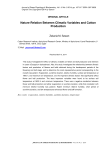
Nature relation between climatic variables and cotton production
Статья научная
This study investigated the effect of climatic variables on flower and boll production and retention in cotton ( Gossypium barbadense ). Also, this study investigated the relationship between climatic factors and production of flowers and bolls obtained during the development periods of the flowering and boll stage, and to determine the most representative period corresponding to the overall crop pattern. Evaporation, sunshine duration, relative humidity, surface soil temperature at 1800 h, and maximum air temperature, are the important climatic factors that significantly affect flower and boll production. The least important variables were found to be surface soil temperature at 0600 h and minimum temperature. There was a negative correlation between flower and boll production and either evaporation or sunshine duration, while that correlation with minimum relative humidity was positive. Higher minimum relative humidity, short period of sunshine duration, and low temperatures enhanced flower and boll formation.
Бесплатно
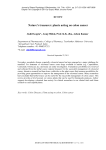
Nature's treasurer: plants acting on colon cancer
Статья обзорная
Nowadays, neoplastic disease, especially colorectal cancer has been emerged as a major challenge for mankind. For treatment of colorectal cancer some drugs available in market (e.g. Capecitabine, Cetuximab, Trinotecan, etc.) and many are under investigation. Tremendous possibilities are reviewed and collected from the herbal source (natural treasure) for the successful management of colorectal cancer. Intensive research had been done worldwide on the plant source that increases possibilities for providing great opportunities to improve the management of the colorectal cancer. Many researchers had concluded that herbal source can be useful for the successful management of colon cancer. This review provides a brief account on various plants that can be used for therapeutic purposes. Author suggests developing a chemical base moiety for clinical researchers to run clinical trials and future research on such capable plants.
Бесплатно
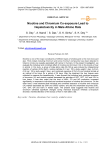
Nicotine and chromium co-exposure lead to hepatotoxicity in male albino rats
Статья научная
Nicotine is one of the major constituents of different types of smoking and is the more toxic part also. Thirty metals including chromium and some chromium compounds have been detected in tobacco smoke are causally associated with cancer in humans. In the present investigation, we evaluate the individual and combined effect of nicotine and chromium (VI) on the toxicity of liver in animal. In this study, a group of male albino rats (80-100 g) were induced by intraperitonial injection of vehicle (0.9% NaCl), nicotine tartrate (0.2 mg / 100 g body weight / day), K2Cr2O7 (0.8 mg / 100 g body weight / day), and combined exposure of K2Cr2O7 and nicotine tartrate at an interval of six hours for a period of 28 days. After the treatment the liver tissues were collected to measure the hepatotoxicity. It was showed that individual and combined exposure of chromium (VI) and nicotine marked decreased the activities of GOT, GPT, ALP and LDH in liver tissue. It was also noted that the level of MDA, CD and NO production increased significantly in response to individual and combined exposure of nicotine and chromium. On the other hand, it was observed that individual and combined exposure of nicotine and chromium (VI) marked decreased the GSH and GSSG content, and also the antioxidant enzymes (SOD, CAT, GPx, GR and GST) in tested organ. The present study suggests that nicotine and chromium exhibited significant changes during individual exposure whereas co-exposure showed a marked alteration of the toxicity of liver in male albino rats.
Бесплатно
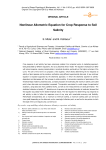
Nonlinear allometric equation for crop response to soil salinity
Статья научная
Crop response to soil salinity has been extensively studied, from empirical works to modelling approach, being described by different equations, first as a piecewise linear model. The equation employed can differ with actual response, causing miscalculation in practical situations, particularly at the higher extremes of the curve. The aim of this work is to propose a new equation, which allows determining the full response to salinity of plant species and to provide a verification using different experimental data sets. A new nonlinear equation is exposed supported by the allometric approach, in which the allometric exponent is salinity-dependent and decreases with the increase in relative salinity. A conversion procedure of parameters of the threshold-slope model is presented; also, a simple procedure for estimating the maximum salinity (zero-yield point) when data sets are incomplete is exposed. The equation was tested in a wide range of experimental situations, using data sets from published works, as well as new measurements on seed germination. The statistical indicators of quality (R 2, absolute sum of squares and standard deviation of residuals) showed that the equation accurately fits the tested empirical results. The new equation for determining crop response to soil salinity is able to follow the response curve of any crop with remarkable accuracy and flexibility. Remarkable characteristics are: a maximum at minimum salinity, a maximum salinity point can be found (zero-yield) depending on the data sets, and a meaningful inflection point, as well as the two points at which the slope of the curve equals unity, can be found.
Бесплатно
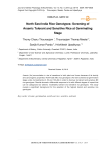
Статья научная
Arsenic (As) accumulation in rice is hazardous to both plant and human because of its toxicity and carcinogenic properties. North-East (NE) rice genotypes (76) were screened at germination stage under As treatments (0, 50 and 100 µM) in order to discover As tolerant and sensitive NE rice genotypes. Results showed a differential response to As with different degree of impact that can be categorized as tolerant, moderately tolerant and sensitive rice genotypes. This study reveals a significant background for the selection of the highest tolerant and sensitive rice genotypes.
Бесплатно
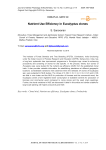
Nutrient use efficiency in eucalyptus clones
Статья научная
The Institute of Forest Genetics and Tree Breeding (IFGTB), Coimbatore, India functioning under the Indian Council of Forestry Research and Education (ICFRE), Dehara Dun, India, has a long term systematic tree improvement programme in Eucalyptus spp. aimed to enhancing productivity and screening of clones for site specific. In the process, twenty four clones of Eucalyptus spp. were studied for the nutrient use efficiency (NUE) from the established clonal trials. It also provides valuable information for establishing plantations at different geographic locations. Considerable variations were observed when the selected 24 clones of Eucalyptus spp. were subjected to NUE studies. The clones of C-188, C-10, C-14, C-19, C-123 and C-186 are falls in one cluster and the NUE for production of biomass and the commercial wood, the Eucalyptus clones of are registered lower consumption of available nutrients for production of biomass and commercial wood compared to ruling clones and the seed origin seedlings. Further, the clonal variations in NUE are discussed in detail in this article and clones suitable for large scale planting with higher productivity and NUE.
Бесплатно
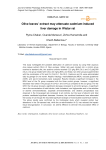
Olive leaves’ extract may attenuate cadmium-induced liver damage in Wistar rat
Статья научная
This study investigates the possible attenuation of cadmium toxicity by using fresh aqueous olive leaves extract (OLE) of Olea europea. Wistar rats were divided into a control group received a standard diet, two positive controls received 0.25 g/kg BW (OL1) and 0.5 g/kg BW (OL2), one group treated with CdCl2 (40 mg/kg BW), and finally, two other groups supplemented with the combination of Cd and OL (Cd+OL1, Cd+OL2). Cadmium and OL were administrated daily by gavage for one month. Hepatic histology, malondialdehyde (MDA), reduced glutathione (GSH), and serum biomarkers were evaluated. Results indicate a significant increase in the MDA level of the Cd group compared with the three control groups, however, a significant decrease was noted in the groups of Cd+OL1 and Cd+OL2 compared to the Cd group. For the GSH, the Cd group showed a significant decrease compared to all control groups. A significant rise in the concentration of total bilirubin, total cholesterol, and triglycerides and in the activities of alanine aminotransferase, aspartate aminotransferase, and alkaline phosphatase was observed in the Cd-exposed rats compared to all controls, but the level of albumin and total proteins manifested significant decrease. However, the combined treatments have attenuated the toxicity of Cd through the recorded significant changes of most studied biochemical markers. The above results were confirmed by the histological study which revealed certain liver alterations in the Cd-exposed rats, while the co-administration of OL has reduced the hepatic tissue disorganization. In conclusion, OL seems effective to diminish the prooxidative effect of cadmium.
Бесплатно
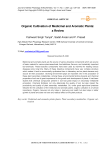
Organic Cultivation of Medicinal and Aromatic Plants: a Review
Статья научная
Medicinal and aromatic plants are the source of various bioactive components which are source of basic material for various pharmaceuticals, food additives, flavours, and industrially important bio-chemicals. These bioactive components have been used by mankind for treating various diseases since long time. Many of these bioactive components have very complex structure which makes it hard to economically synthesize them in laboratory and so plants became only source for their production. Growing environment plays an important role in the production of these plant secondary metabolites. Among these environmental factors physical and chemical properties of soil are of great importance for the growth and development of plants. It had been studies that chemical compounds present in soil had great impact on secondary metabolite production. Chemical fertilizers not only deteriorate the quality of soil but also impact the productivity and quality of plant secondary metabolites. So, under good agricultural practices followed for the cultivation of the medicinal and aromatic plants, organic cultivation is of utmost importance. Organic manures not only helps in improving soil health but also helps in better growth of plants and does not have any residual effect on the plant produce.
Бесплатно
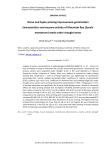
Статья научная
Impacts of various concentrations of polyetylenglycol 6000 (PEG 6000) (0, -9, -11, -13 and -15 bar) and hydro priming on Mountain Rye (secale montanum) germination characteristic and enzyme activity were evaluated under drought stress in the seed laboratory of Natural Resources Faculty, University of Tehran, Karaj, Iran. Analyze of variance for hydro priming showed that temperature × time of priming interaction was significantly for germination percentage (GP), normal seedling percentage (NSP), coefficient of velocity of germination (CVG), seedling vigor index (SVI), coefficient of allometry (AC) and seedling length (SL) under drought stress and for osmo priming showed that Concentration of PEG × Temperature × Time of priming interaction was significantly for all traits under drought stress. Results of interaction effects for hydro priming showed that the highest GP (53%) and NSP (23.5%) were attained from hydro priming for 16h at 15◦C and the highest CVG (0.21) and AC (0.49) were attained from hydro priming for 8h at 10◦C, also hydro priming for 8h at 15◦C increased SL (3.15) as compared to the unprimed. Osmo priming with concentration of -15 bar PEG for 24h at 15◦C increased GP (80.5 %), GI (17.9), NSP (45 %), SVI (257.85) and SL (5.73 cm) and decreased MTG as compared to the unprimed and other treatments of osmo priming. The highest CVG was attained from concentration of -9 bar PEG for 24h at 10◦C. the highest AC was attained from concentration of -9 bar PEG for 12h at 15◦C. Also osmo and hydro priming increased catalase (CAT) and ascorbate peroxidase (APX) as compared to the unprimed.
Бесплатно
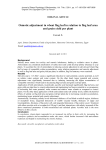
Osmotic adjustment in wheat flag leaf in relation to flag leaf area and grain yield per plant
Статья научная
Background Salinity stress causes ion toxicity and osmotic imbalances, leading to oxidative stress in plants. Antioxidants are considered ameliorators of saline stress and could develop salinity tolerance in crop plants. To ascertain the role of antioxidants in inducing osmotic adjustment in salt stressed wheat flag leaf in terms of compatible solutes accumulation, water relations parameters and osmotic adjustment as well as flag leaf area and grain yield per plant, in addition, flag leaf anatomy were examined. Results Salt stress up to 11.5 dSm-1 causes a significant reduction in water potential, osmotic potential, as well as relative water content, and water content. On the other hand, turgor potential and osmotic adjustment were significantly increased due to inducing increasing the higher accumulation of compatible osmolytes which leads to decreasing flag leaf area and grain yield per plant. Application of both antioxidants, in particular, ascorbic acid increased significantly flag leaf area, and grain yield per plant due to osmotic adjustment and maintaining leaf turgor potential as a consequence of increasing leaf water potential, water content and relative water content as compared to control plants. On the other hand, application of both antioxidants under all salinity levels, ify the harmful effects of salinity on flag leaf area and grain yield per plant due to increasing osmolyte accumulation, maintaining turgor potential and osmotic adjustment. Anatomically, increasing salinity levels decreased thickness of leaf blade at midrib region, thickness of mesophyll tissue, tangential dimension of midrib vascular bundle, thickness of upper and lowerepidermis, thickness of big motor cell, and tangential dimension of big xylem vessel. Treatment with either ascorbic acid or tocopherol at 100 mg/L and their interactions with salinity increased all the above mentioned parameters in both nonsalinized and salinized plants. Ascorbic acid is the most effective in this concern. Conclusion In conclusion, wheat plants responded to an increased ion influx in their cells by increasing the osmolytes synthesis and accumulation under salt stress, which further increased with antioxidants treatment and helped in maintaining the osmotic balance.
Бесплатно
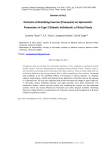
Статья научная
Pranayama aims by carrying the involuntary functions of the respiratory mechanism within human control. The term pranayama has comprised by two words: Prana + Ayama. Prana is the vital force and energy which permeates the whole universe. Prana is novel subtle than air and can be defined as the energy essence that is within everything in the universe. In present time emphasis is on the beneficial effects of Pranayam in various diseases i.e. diabetes mellitus, hypertension, obesity and depression by application of specific exercise like walking in a planned way. This was also explained and proved by American college of sport medicine. In Ayurveda various breathing exercise and yogic practices have been mentioned. The respiratory System, central nervous system and cardiovascular system are the important systems which are mostly affected by Pranayam and other physical activities. Breathing exercise is highly effective in endorsement of respiratory system and management of diseases related to respiratory system.
Бесплатно
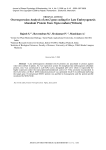
Статья научная
Late embryogenesis abundant (LEA) proteins are speculated to protect against water stress deficit in plants. An over expression system for mungbean late embryogenesis abundant protein, emv2 was constructed in a pET29a vector, designated pET-emv2 which is responsible for higher expression under the transcriptional/translational control of T7/lac promoter incorporated in the Escherichia coli BL21 (DE3).Induction protocol was optimized for pET recombinants harboring the target gene. Overexpressed EMV2 protein was purified to homogeneity and the protein profile monitored by SDS-PAGE.
Бесплатно
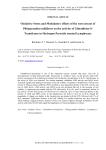
Статья научная
Glutathione-S-transferase is one of the important enzyme systems that plays vital role in decomposition of lipid hydro-peroxides formed due to oxidative stress. In the present study GST activity increased in the lymphocytes treated with increasing concentration of H2O2, and decrease in the levels of GSH was observed. For similar treatment conditions LDH activity and MDA levels increased significantly leading to decrease in the cell viability. Treatment of lymphocytes with the root extract of Phlogacanthus tubiflorus (PTE) resulted in dose dependent decline in the GST activity and rise in GSH levels. LDH activity and MDA levels also declined that led to the increase of cell viability. Lymphocytes pre-treated with the PTE followed by H2O2 (0.1 and 1%) treatment, decline in the activity of GST and increase in GSH levels was observed. Also we have observed decline in the activity of LDH and MDA levels in the lymphocytes for both 0.1 and 1% of H2O2 though the magnitude of change was higher in the lymphocytes pre-treated with the PTE followed with 1% of H2O2 treatment. Significant increase in the cell viability for similar conditions was also observed. These findings suggest protective function of the root extracts might be through modulation of GST activity and levels of GSH and might find application in Chemomodulation in future.
Бесплатно
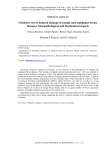
Статья научная
Increasing evidences indicate involvement of free radicals in the pathogenesis of benign and malignant breast diseases. Free radicals are highly reactive molecules and react with non-radicals in chain reaction leading to formation of new free radicals. If the defense mechanism of body fails to combat them, these free radicals pose a threat of injuring tissues by reacting with cell lipids. Lipids in the cell membrane undergo degradation to form hydroperoxides, which decompose to form a variety of products including malondialdehyde (MDA). MDA therefore was used as a marker to assess oxidative damage of cells and tissues. The aim of the present study was to assess the status of oxidative stress in the patients of benign and malignant breast diseases. Study has been made on the blood samples of 25 cases of benign breast disease and on an equal number of breast carcinoma patients. 20 healthy subjects were taken as the control cases. Mean MDA levels were significantly raised with depletion of antioxidant activity in all the patients in comparison to their control group suggesting the role of oxidative damage in the aetiopathogenesis of disease.
Бесплатно
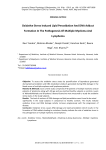
Статья научная
Objective: To access the oxidative stress status by quantification of byproducts generated during lipid peroxidation and DNA breakdown products generated during DNA damage in the blood serum of multiple myeloma and lymphoma patients. Material & Methods: Case control study comprised of 40 patients of multiple myeloma and 20 patients of lymphoma along with 20 age and sex-matched healthy subjects as controls. Levels of Malondialdehyde and 8-hydroxy-2-deoxy-Guanosine were measured to study the oxidative stress status in the study subjects. Results: The level of markers of DNA damage and lipid peroxidation were found to be raised significantly in the study subjects in comparison to healthy controls. The results indicate oxidative stress and DNA damage activity increase progressively with the progression of disease. Conclusion: Oxidative stress causes DNA damage and Lipid peroxidation which results in the formation of DNA adducts leading to mutations thereby indicate the role of oxidative stress in the pathogenesis of multiple myeloma and lymphoma.
Бесплатно
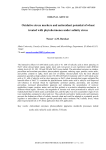
Статья научная
The interactive effects 0.5 mM indole acetic acid or 0.1 mM of salicylic acid as shoot spraying on NaCl wheat stressed plant organs (spike, shoot and root) grown in pot experiment under different salinity levels (0, 50, 100, 150 and 200 mM NaCl) were studied. The antioxidant enzymes as catalase, peroxidase and ascorbate peroxidase, photosynthetic pigments, reducing sugar, proteins, amino acids, and proline contents in spike, shoot and root of salinity stressed plants were the most affected parameters specially at high salinity levels (150-200 mM NaCl).Treatments with 0.5 mM indole acetic acid or 0.1 mM of salicylic acid as shoot spraying on NaCl wheat stressed plant organs mitigated the harmful effect of NaCl. To conclude the phytohormone acetic acid or salicylic acid salt tolerance in stressed wheat by significantly catalase, peroxidase, and ascorbate peroxidase, increased photosynthetic pigments and the accumulation of nontoxic metabolites (sugars, proteins, amino acid and free proline) as a protective adaptation mechanismin different wheat organs. However, the magnitude of increase was more pronounced in salicylic acid treated plants than in indole acetic acid treated ones, and the spike was more accumulator organ of non toxic metabolites compared to shoot and root. salicylic acid and/or indole acetic acid treatments prevents the deleterious effects of salinity stressed wheat and could be adopted as a potential growth regulator or antioxidant to improve growth particularly under moderate NaCl salinity levels, wheat plant respond positively to SA foliar application than IAA application.
Бесплатно
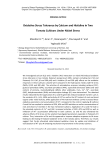
Oxidative stress tolerance by calcium and histidine in two tomato cultivars under nickel stress
Статья научная
We investigated calcium (Ca) and L-histidine (His) interaction on nickel (Ni)-induced oxidative stress tolerance in two tomato (Solanum lycopersicum Mill.) cultivars including Cal-J N3 and Petoearly CH. CaCl 2 (0 and 300 µM) and L-histidine (0 and 300 µM) effects on the oxidative responses in these cultivars cultured were compared in the hydroponic media under Ni stress (NiSO 4; 0,150 and 300 µM). The activities of antioxidative enzymes including catalase (CAT), guaiacol peroxidase (GPX), ascorbate peroxidase (APX), superoxide dismutase (SOD) and total content of proteins, malondialdehyde (MDA), other aldehydes, H 2O 2, Ca 2+, Ni 2+, ascorbate (ASC), dehydroascorbate (DHA) and electrolytes leakage (EL) were determined. The obtained results indicated that the application of Ca and His generally reduced oxidative markers such as the contents of EL, H 2O 2, MDA and activity of CAT as well as the Ni 2+content of root and shoot organs under nickel toxicity, while application of Ni treatment without Ca+His increased these oxidative parameters and accumulation of Ni 2+, compared to the control. Applying Ni without Ca and His has resulted in reduction of GPX, APX and SOD activities as well as concentrations of root and shoot Ca 2+and ASC in the two mentioned cultivars. Application of Ca and His lead to the elevated contents of Ca 2+ and ASC, increased activities of GPX, APX and SOD as well as inhibition of Ni 2+ accumulation differently in both cultivars. Ca and His also alleviated the adverse effects of Ni stress on the selected investigated parameters especially in Petoearly CH cultivar. Thus, interaction of Ca and His appeared to improve adaptive responses to Ni stress leading to decreasing Ni-induced oxidative stress in the tomato plants. Therefore, our results suggest that Ca+His alleviated nickel-induced oxidative stress by uptake and inhibition of translocation of Ni 2+ plus Ni chelating mechanism improvement in the tomato cultivars.
Бесплатно
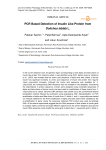
PCR based detection of insulin like protein from Dolichos lablab L
Статья научная
In the current research work, the genetic region corresponding to both alpha and beta chains of insulin like protein from Dolichos lablab L was identified using PCR. Earlier study by Venâncio et al. , (2003) has revealed that the amino acid sequence of alpha and beta chains of bovine insulin has significant similarity to amino acid sequence of insulin like protein from legume Vigna unguiculata (cowpea). Although the amino acid sequence was available for V. unguiculata , the corresponding DNA sequence was not available in the database. Considering the resemblance in protein sequence, primers were designed using nucleotide sequences of alpha and beta chains of bovine insulin and were used for amplification of these chains from V. unguiculata and D. lablab . Genomic DNA extraction was carried out by the conventional ethanol precipitation method followed by purification using preparative AGE. Standardization on PCR amplification of alpha and Beta chain of Insulin from D. lablab L...
Бесплатно

